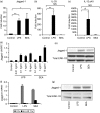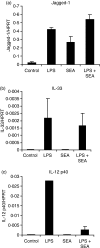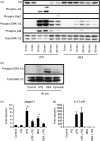Selective induction of the Notch ligand Jagged-1 in macrophages by soluble egg antigen from Schistosoma mansoni involves ERK signalling
- PMID: 19019093
- PMCID: PMC2712101
- DOI: 10.1111/j.1365-2567.2008.02979.x
Selective induction of the Notch ligand Jagged-1 in macrophages by soluble egg antigen from Schistosoma mansoni involves ERK signalling
Abstract
Soluble egg antigen (SEA) from the helminth Schistosoma mansoni promotes T helper type 2 (Th2) responses by modulating antigen-presenting cell function. The Jagged/Notch pathway has recently been implicated in driving Th2 development. We show here that SEA rapidly up-regulated mRNA and protein expression of the Notch ligand Jagged-1 in both murine bone marrow-derived macrophages (BMMs) and human monocyte-derived macrophages (HMDMs). Another potential Th2-promoting factor, interleukin (IL)-33, was not transcriptionally induced by SEA in BMMs. Up-regulation of Jagged-1 mRNA by SEA was also apparent in conventional dendritic cells (DCs), although the effect was less striking than in BMMs. Conversely, SEA-pulsed DCs, but not BMMs, promoted IL-4 production upon T-cell activation, suggesting that Jagged-1 induction alone is insufficient for instructing Th2 development. A comparison of the responses initiated in BMMs by SEA and the bacterial endotoxin lipopolysaccharide (LPS) revealed common activation of extracellular signal-regulated kinase-1/2 (ERK-1/2) and p38 phosphorylation, as well as induction of Jagged-1 mRNA. However, only LPS triggered IkappaB degradation, phosphorylation of c-Jun N-terminal kinase (Jnk) and signal transducer and activator of transcription 1 (Stat1) Tyr701, and IL-33 and IL-12p40 mRNA up-regulation. Inducible gene expression was modified by the presence of the macrophage growth factor colony-stimulating factor (CSF)-1, which inhibited Jagged-1 induction by SEA and LPS, but enhanced LPS-induced IL-12p40 expression. Unlike LPS, SEA robustly activated signalling in HEK293 cells expressing either Toll-like receptor 2 (TLR2) or TLR4/MD2. Pharmacological inhibition of the ERK-1/2 pathway impaired SEA- and LPS-inducible Jagged-1 expression in BMMs. Taken together, our data suggest that Jagged-1 is an ERK-dependent target of TLR signalling that has a macrophage-specific function in the response to SEA.
Figures







Similar articles
-
Combined TLR2 and TLR4 ligation in the context of bacterial or helminth extracts in human monocyte derived dendritic cells: molecular correlates for Th1/Th2 polarization.BMC Immunol. 2009 Feb 4;10:9. doi: 10.1186/1471-2172-10-9. BMC Immunol. 2009. PMID: 19193240 Free PMC article.
-
Schistosoma mansoni egg antigen-mediated modulation of Toll-like receptor (TLR)-induced activation occurs independently of TLR2, TLR4, and MyD88.Infect Immun. 2008 Dec;76(12):5754-9. doi: 10.1128/IAI.00497-08. Epub 2008 Sep 29. Infect Immun. 2008. PMID: 18824534 Free PMC article.
-
Contribution of a Streptococcus mutans antigen expressed by a Salmonella vector vaccine in dendritic cell activation.Infect Immun. 2011 Sep;79(9):3792-800. doi: 10.1128/IAI.05338-11. Epub 2011 Jul 11. Infect Immun. 2011. PMID: 21746857 Free PMC article.
-
Autoamplification of Notch signaling in macrophages by TLR-induced and RBP-J-dependent induction of Jagged1.J Immunol. 2010 Nov 1;185(9):5023-31. doi: 10.4049/jimmunol.1001544. Epub 2010 Sep 24. J Immunol. 2010. PMID: 20870935 Free PMC article.
-
Notch-1 up-regulation and signaling following macrophage activation modulates gene expression patterns known to affect antigen-presenting capacity and cytotoxic activity.J Immunol. 2006 May 1;176(9):5362-73. doi: 10.4049/jimmunol.176.9.5362. J Immunol. 2006. PMID: 16622004
Cited by
-
Collagen/β1 integrin signaling up-regulates the ABCC1/MRP-1 transporter in an ERK/MAPK-dependent manner.Mol Biol Cell. 2012 Sep;23(17):3473-84. doi: 10.1091/mbc.E12-02-0132. Epub 2012 Jul 11. Mol Biol Cell. 2012. PMID: 22787275 Free PMC article.
-
Schistosome egg antigens elicit a proinflammatory response by trophoblast cells of the human placenta.Infect Immun. 2013 Mar;81(3):704-12. doi: 10.1128/IAI.01149-12. Epub 2012 Dec 17. Infect Immun. 2013. PMID: 23250950 Free PMC article.
-
TLR2 directing PD-L2 expression inhibit T cells response in Schistosoma japonicum infection.PLoS One. 2013 Dec 20;8(12):e82480. doi: 10.1371/journal.pone.0082480. eCollection 2013. PLoS One. 2013. PMID: 24376539 Free PMC article.
-
Immunological mechanisms involved in macrophage activation and polarization in schistosomiasis.Parasitology. 2023 Apr;150(5):401-415. doi: 10.1017/S0031182023000021. Epub 2023 Jan 5. Parasitology. 2023. PMID: 36601859 Free PMC article. Review.
-
Role of Notch signaling in regulating innate immunity and inflammation in health and disease.Protein Cell. 2016 Mar;7(3):159-74. doi: 10.1007/s13238-016-0250-0. Epub 2016 Mar 2. Protein Cell. 2016. PMID: 26936847 Free PMC article. Review.
References
-
- Kidd P. Th1/Th2 balance: the hypothesis, its limitations, and implications for health and disease. Altern Med Rev. 2003;8:223–46. - PubMed
-
- Miyatake S, Arai N, Arai K. Chromatin remodeling and T helper subset differentiation. IUBMB Life. 2000;49:473–8. - PubMed
-
- Schmitz J, Owyang A, Oldham E, et al. IL-33, an interleukin-1-like cytokine that signals via the IL-1 receptor-related protein ST2 and induces T helper type 2-associated cytokines. Immunity. 2005;23:479–90. - PubMed
Publication types
MeSH terms
Substances
LinkOut - more resources
Full Text Sources
Research Materials
Miscellaneous

